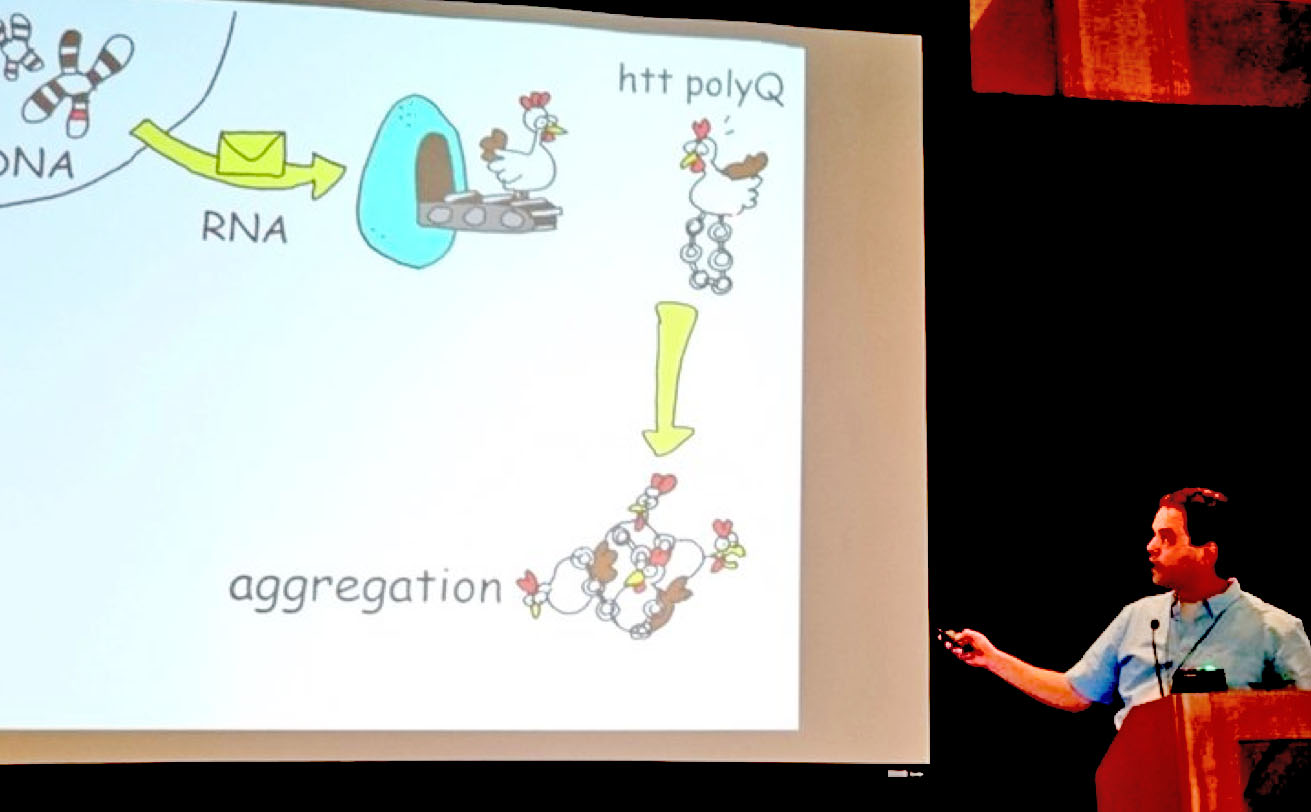
Huntington's Disease Therapeutics Conference 2016 – day 2
Strategies for getting rid of mutant huntingtin & clinical trial updates: day 2 of the HD therapeutics conference

After an exciting day of science yesterday, day 2 saw updates on strategies to rid cells of the harmful mutant huntingtin protein and exciting reports on current and planned clinical trials.
Wednesday morning – huntingtin lowering strategies
Huntingtin lowering or “gene silencing” may be the most exciting potential HD treatment strategy. Since every case of HD is due to inheriting a mutant HD gene, getting rid of the effects of that gene is a very attractive idea! We’ve talked a lot about gene silencing at HDBuzz – catch up here if the topic is new to you.

Ignacio Munoz-Sanjuan is giving an update about efforts at the CHDI foundation to develop “biomarkers” to improve silencing studies. A “biomarker” is some kind of lab test that can be done, in this case, to see if your expeimental drug is doing what you’d like it to. With HD gene silencing studies, the goal is to reduce levels of the protein made from the HD gene.
In the lab, we can easily measure how much mutant huntingtin protein is being made to see if silencing drugs work. But once we start treating human HD patients, we can’t easily get access to the most important tissue we need to treat – the brain. The techniques that Munoz-Sanjuan is describing include imaging techniques that let researchers check on brain health non-invasively. In mice treated with HD gene silencing drugs, several of these imaging techniques show improvements, no brain surgery required!
These lab results are now being examined in HD patients – hopefully they will empower future silencing studies. Beyond imaging, we can try to sample brain levels of the huntingtin protein more directly. Recently, multiple groups have developed ways to measure huntingtin in brain fluid. These tools are already being incorporated into ongoing gene silencing studies!
Pavlina Konstantinova is the director of emerging technologies at uniQure, who have an interest in developing gene silencing for HD. uniQure uses tiny viruses to deliver a small piece of DNA to cells, which instructs them to reduce levels of the huntingtin protein. We’ve recently covered similar viral delivery techniques on HDBuzz. uniQure is testing their gene silencing viruses in HD mice in collaboration with the help of HD researchers. uniQure is also working to better understand whether it’s safe to reduce levels of the HD gene in long-term mouse studies.
The final presentation of the morning is from Jodi McBride, who studies HD gene silencing in both mice and monkeys. Larger animals, like monkeys, are important to study because they have large, complex, brains like humans. Fixing mice is easy! McBride raises a critical issue for gene silencing studies – how safe is it to reduce levels of the huntingtin protein? McBride’s lab is silencing the HD gene in the brains of monkeys to see if this treatment has any toxic side effects. McBride’s team is experimenting with a new brain scanner that lets surgeons infuse gene therapy virus much more accurately. McBride is also working to develop a monkey model of HD by delivering mutant HD genes to their brains using viruses.
Via videoconference, Feng Zhang addresses the meeting on the incredibly hot topic of ‘genome editing’. Scientists once believed that we were stuck with the DNA we were born with, but new technologies make it possible to edit DNA. Zhang has conducted pioneering research with the most widely-used genome editing tool called CRISPR/Cas9. We’ve covered this technology on HDBuzz before. The CRISPR/Cas9 system originates from bacteria, who use it as a defense mechanism against viruses. Researchers have taken advantage of the CRISPR system to make specific changes to DNA in other types of cells, including human ones. Zhang describes the huge zoo of CRISPR/Cas9 modifications that scientists have devised to make specific types of genetic changes. Zhang’s lab is working to refine and improve the CRISPR/Cas9 system to make sure that it only makes desired changes to DNA. If you’re going to engineer a system that can modify DNA, you want to make sure it follows your instructions!
“The safety board has allowed us to move to the higher dose of gene-silencing drug. This means there were no safety concerns in the first group of patients.”
David Rubinsztein from Cambridge University studies autophagy – one of the garbage-disposal mechanisms in cells. Cellular gunk builds up in HD and increasing garbage removal might help. Drugs to increase autophagy have been tested in HD mice and shown some benefits but the drugs have bad side effects. The search is on for ‘cleaner’ drugs to increase autophagy. Rubinsztein’s team have identified and are studying new ways of activating autophagy. He’s also looking at the relationship between autophagy garbage disposal, and trafficking – the movement of substances round cells. Genetic mutations that affect trafficking may be involved in some caes of Alzheimer’s and Parkinson’s disease.
Eric Reits from University of Amsterdam is interested in another garbage removal system – the proteosome. The proteosome is like a woodchipper in our cells – unwanted stuff is fed into it and broken into little pieces. Reits has developed a new way of looking at which proteins are flagged for woodchipping by the proteosome. The proteosome might help get rid of mutant huntingtin protein. But the proteosome seems to be less efficient in parts of the brain affected most by HD. Can we activate these proteosomes to help get rid of mutant huntingtin? He’s working on it!
Wednesday afternoon: clinical trial updates
This afternoon we’re getting a blitz of updates from drug companies currently running HD clinical trials. Neal Simon (Azevan Pharmacuticals), describes their STAIR trial with a drug targeting irritability in HD patients. Their first study, designed to see whether the drug is safe, will begin enrolling patients in late March/early April. While establishing the drug is safe, Azevan will also explore whether their drug improves irritability in HD patients.
Marielle Delnomdedieu (Pfizer) updates the conference on the 4 studies they’re currently doing to establish if their drug helps HD. This drug blocks the activity of a brain enzyme called “PDE10” – we’ve covered this topic on Buzz. Pfizer has determined that the drug is safe and well-tolerated in HD patients. They’re completed 91% of the recruitment for the Amaryllis trial, which is investigating whether the drug improves HD symptoms. In parallel, they’re also running studies to understand if the drug improves the function of important brain circuits in HD patients.
John Leonard (Vaccinex) updates the crowd about the progress of their SIGNAL trial. The SIGNAL trial is divided into two groups, ‘cohort A’ and ‘cohort B’, the first group of 36 patients is completely recruited. The second group is recruiting now, with a goal of having the final patient visit occur in September 2017.

The final clinical trial blitz is from Sarah Tabrizi (University College London) about the HTTRx-CS1 ‘gene silencing’ study she’s leading with Roche and Ionis. This trial is investigating whether “antisense oligonucleotides” (ASOs) that reduce levels of the huntingtin protein are safe. Because ASOs can’t get into the brain on their own, they have to be delivered by infusion into the spinal fluid around the brain. This is done by infusing the drug into the spinal fluid using a thin needle every four weeks.
Tabrizi shows data from monkeys treated in the same way as the humans patients. ASO treatment leads to robust reductions of huntingtin protein across the brain.
Tabrizi: “The safety board has allowed us to move to the higher dose”. This means there were no safety concerns in the first group of patients. Things are moving quickly! Tabrizi: “Estimated study completion date September 2017”
Tabrizi concludes: “the real research heroes in the HD community are the patients an their families that give all their time”.
In the today’s final talk, Marcus Munafo (University of Bristol) suggests some ways in which science can be made more reliable with fewer false starts.
A very exciting afternoon! A huge amount of work happening in clinics around the world to put to use all the basic science we’ve seen.
For more information about our disclosure policy see our FAQ…


